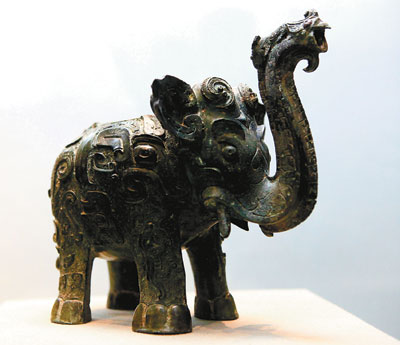
Wang Yuanyuan, Cheng Lulu
cheekywang@hotmail.com
A TOTAL of 116 bronzeware items, which were found in Hunan Province and were held at Hunan Provincial Museum, are being exhibited at Shenzhen Museum in Futian District.
It is the first time bronzeware from Hunan has been exhibited outside the province. The aim is to introduce and demonstrate the bronze making history of the ancient Central China region, Cai Ming, exhibition planner and a bronzeware expert at Shenzhen Museum, said Friday.
Among all the exhibits, a bronze elephant is the earliest. The elephant with a unique shape and style is covered with depictions of various animals such as snakes, tigers, dragons and birds. “It is well known that in ancient times, elephants were mainly found in Africa and South Asia, so elephant artwork was very rare in China. That is why this piece is so unique and precious,” Cai said.
Another precious item is a bronze tripod with a human mask. It is the only bronze tripod decorated with a bronze human face from the Shang (1,600-1,100 B.C.) and Zhou (1,100-256 B.C.) dynasties.
Other items also have particular shapes and designs. For example, one bronze container is adorned with designs of four horses. “Although this piece cannot be seen as anything fancy, its shape and design are interesting. Similar designs can only be seen in Hunan in ancient times,” Cai said.
Bronzeware, apart from its use as vessels or weapons, was a symbol of political power during the Bronze Age in China.
It plays a very important role in the study of ancient Chinese history and art. The numerous varieties, complicated shapes, delicate patterns, colorful inscriptions and casing technology give a vivid portrayal of the political, economic, cultural and technological characteristics of China’s early civilization.
Chinese people have been making bronzeware for more than 6,000 years. Most bronzeware was found in Henan, Shaanxi and Shandong provinces and was made during the Xia (2,100-1,600 B.C.), Shang and Zhou dynasties. With the discovery of a growing number of ancient tombs along the Yangtze River, the bronzeware culture in ancient Central China has gradually drawn public attention over the past 20 years.
Located around the middle reach of the Yangtze River, Hunan Province has always been an important hub for cultural communication and exchange between North China and South China. In the Spring and Autumn Period (770-476 B.C.) and the Warring States Period (475-221 B.C.), Hunan was under the administration of the State of Chu.
Chu was among the five Hegemons of the Spring and Autumn Period and also one of the seven important vassal states of the Warring States Period. During its prime, the state covered a vast area, and had an army boasting thousands of soldiers. Chu controlled wholly, or in part, nine provinces and cities of today. These included Hubei, Hunan, Jiangxi, Anhui, Jiangsu, Zhejiang, Shandong and Chongqing.
So far, more than 300 bronzeware items had been found in the province. Due to the cultural and economic exchanges between Hunan and North China, bronzeware items made in the province gradually developed their own style.
“The bronzeware in ancient North China could be found in large numbers, while bronzeware items in Hunan were all found individually. Meanwhile, due to the close communication between Hunan and Guangdong provinces, Guangdong bronzeware is heavily influenced by that of Hunan,” Cai said.
Time: Until May 1
Ticket: Free
Hours: 10 a.m.-6 p.m. (closed Mondays)
Add: Shenzhen Museum, Block A, Civic Center, Futian District (福田区市民中心A座深圳博物馆)
Metro: Civic Center Station (市民中心站), Exit C
|

